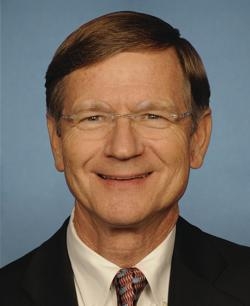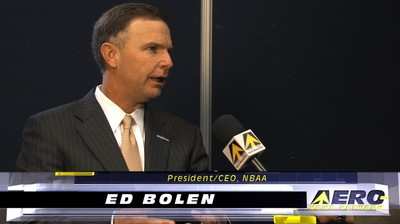Congressman Smith Strongly Critical Of The Agency, NBAA, GAMA Support ICAO Standards
The U.S. Environmental Protection Agency (EPA) is proposing to find under the Clean Air Act that greenhouse gas (GHG) emissions from commercial aircraft contribute to the pollution that causes climate change endangering the health and welfare of Americans. At the same time, the agency is releasing information about the international process already underway by the International Civil Aviation Organization (ICAO) for developing carbon dioxide (CO2) standards for aircraft and EPA’s participation in that process. EPA is now seeking public input to inform future steps by the agency.

For the past five years, ICAO — a specialized body of the United Nations with 191 member states — has been working with the aviation industry and other stakeholders to develop coordinated, international CO2 emissions standards for aircraft. EPA and the FAA, representing the United States, are participating in ICAO’s process to ensure that any standards achieve meaningful CO2 emissions reductions through policies that are equitable across national boundaries.
The ICAO standards are expected to be adopted in early 2016. The items issued in the NPRM by EPA lay the necessary foundation for the development and implementation of a domestic aircraft standard, in accordance with U.S. law and the ICAO process.
The EPA says that U.S. aircraft emit roughly 11 percent of GHG emissions from the U.S. transportation sector and 29 percent of GHG emissions from all aircraft globally. In 2009, EPA determined that GHG pollution from cars and light trucks threatens Americans' health and welfare by leading to long-lasting changes in our climate that can have a range of negative effects. Since then, the EPA says the body of science on human-induced climate change has strengthened, supporting this proposed finding — under a different section of the Clean Air Act — that GHGs emitted from aircraft engines contribute to pollution that causes climate change endangering public health and welfare. The agency said this action supports the goals of the President’s Climate Action Plan to reduce emissions from large sources of carbon pollution.
It does not, however, apply to small piston-engine planes (the type of plane often used for recreational purposes), or to military aircraft.
Once this action is published in the Federal Register, it will be open for a 60-day public comment period. Any future domestic actions toward aircraft engine standards would also be open to public comment and review before they could take effect.

U.S. House Science, Space, and Technology Committee Chairman Lamar Smith (R-TX) (pictured) blasted the EPAs move.
“The sky is the limit when it comes to how much of the U.S. economy the EPA wants to control," Smith said in a statement posted to the committee website. "The EPA today released a finding that emissions from commercial airplanes are harmful to human health, which opens the door for new regulations. Such regulations would increase the price of airfare for Americans and harm our domestic carriers. Over the last fifty years, the fuel efficiency of jetliners has increased by 70 percent. Incentives are already in place to make air travel more energy efficient. This proposal is the next leg of a nonstop journey by the EPA to control how Americans live, work and travel.”
The NBAA says it is closely evaluating the announcement that the agency intends to consider new regulations for carbon emissions from aircraft.
When the EPA's intention was announced, NBAA was quick to raise concerns of its own, pointing out that aviation emissions account for a mere two percent of all transportation emissions globally, and emissions from general aviation aircraft account for only a tiny portion of all aviation emissions.
The agency's announcement – detailed in an advanced notice of proposed rulemaking (ANPRM) – is based on an "endangerment finding," focused on aircraft emissions. The endangerment finding could prompt the EPA to propose any new aircraft-emissions regulations under the Clean Air Act of 1970.

The EPA's ANPRM is not an actual proposed rule, but simply a notice that the agency may move ahead in proposing aircraft-emissions regulations. NBAA is thoroughly reviewing the ANPRM to determine what specific implications the EPA's plans might have for business aviation. NBAA President and CEO Ed Bolen said the Association will file comments on the ANPRM following a review of the document, which NBAA will undertake in collaboration with its Member Companies and the broader aviation community.
NBAA has continually worked with a coalition of other industry stakeholders regarding aircraft emissions. The Association has representation on national and international working groups – represented by general aviation, the airlines, manufacturers and others – that is focused on emission policies.
"The aviation community has long been committed to pursuing effective and workable efforts to lower the industry's carbon footprint,” said Bolen. "Over the past several decades, the industry has enormously improved fuel efficiency, and continues to do so, through the development of new technologies, the promotion of flight-procedures that reduce emissions and ongoing research and testing of alternate fuels. We will make these points very clearly in our comments to the EPA."
GAMA sounded similar themes in a statement released Thursday.
"The global general aviation manufacturing industry represented by GAMA reiterates its commitment to the ongoing work at the International Civil Aviation Organization (ICAO) to develop an aircraft emissions standard," the statement reads. "The EPA’s draft finding is a required step in the U.S. rulemaking process under the Clean Air Act and sets the stage for the implementation in the U.S. of a CO2 standard for aircraft expected to be adopted by ICAO in 2016.

"GAMA member companies continue to be instrumental in the technical work that began in 2010 at ICAO to develop a CO2 standard for aircraft. The global business aviation community has also pledged to do its part to address climate change by achieving a 2 percent improvement in fuel efficiency through 2020 and carbon-neutral growth from 2020 onwards, subject to infrastructure and technology advances by both industry and governments worldwide."
“Aviation is the most global of all industries, and it is important that aviation environmental standards be set by ICAO,” said GAMA President and CEO Pete Bunce. “The EPA’s draft finding recognizes this, and we agree with the agency’s commitment to the ICAO process to finalize a CO2 standard that is environmentally beneficial and that allows aviation to grow in a sustainable manner.”
 ANN's Daily Aero-Term (04.24.24): Runway Lead-in Light System
ANN's Daily Aero-Term (04.24.24): Runway Lead-in Light System ANN's Daily Aero-Linx (04.24.24)
ANN's Daily Aero-Linx (04.24.24) Aero-FAQ: Dave Juwel's Aviation Marketing Stories -- ITBOA BNITBOB
Aero-FAQ: Dave Juwel's Aviation Marketing Stories -- ITBOA BNITBOB Classic Aero-TV: Best Seat in The House -- 'Inside' The AeroShell Aerobatic Team
Classic Aero-TV: Best Seat in The House -- 'Inside' The AeroShell Aerobatic Team Airborne Affordable Flyers 04.18.24: CarbonCub UL, Fisher, Affordable Flyer Expo
Airborne Affordable Flyers 04.18.24: CarbonCub UL, Fisher, Affordable Flyer Expo






